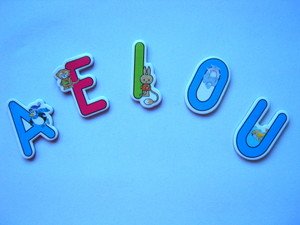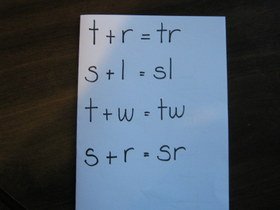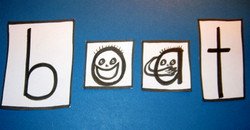Basic Phonics Rules
A Literacy Teacher's Guide
Basic phonics rules help us to read and understand the English language. As a teacher of literacy, I know these rules help my students (both children and adults) with the more difficult aspects of reading, writing and speaking English.
It teaches them to recognise letter patterns in words. Once they have learned them they can re-use those patterns when writing or reading. Recognising letter patterns makes decoding English so much easier. If your child can learn these rules they will become competent readers and spellers with good self-esteem.
Here are five examples of basic phonics rules I teach my students...
Basic Phonics Rule # 1
*Vowels are the letters a, e ,i ,o, u and sometimes include y. When we make a vowel sound our jaw drops. Vowels are the letters in words that make words sound clear. Without them we sound as if we are muttering. No-one would understand us if we spoke without including them.

Below are two sentences. Try reading aloud the first one. None of the words in it contain any vowels.
Th qck brwn fx jmps vr th lz dg
Now read the following sentence. It does contain vowels.
The quick brown fox jumps over the lazy dog.
You'll find this second sentence, the one with vowels, is much easier to understand when it is read aloud. This demonstrates just how important this basic phonics rule is.
Basic Phonics Rule # 2
*Words can be broken up into smaller pieces
or chunks called syllables. Breaking up words makes them easier
to read and to work out how to spell. Every syllable has to have at least one
vowel in it. A word with one syllable like cat has one vowel, a.
A word like America can be broken up into four syllables like this, A
me ri ca.
Basic Phonics Rule # 3

* When two or three consonants are placed side-by-side (called consonant clusters) they are pronounced by running the sounds together like this....
f + l say fl as in flip.
Putting the letters together like this produces a smooth flowing sound, called blending.
There are many combinations of these blends.
Here are a few... fl, tr, cl, st, tw, nk, lk and str.
Some occur at the beginning of a word, like tw in twin.
Others appear at the end of a word like lk in milk and nt in went.
Basic Phonics Rule # 4
* When two vowels are placed side-by-side, in most cases the first vowel says its name and the other is silent. Take for example the word rain. Notice that the a in rain says its name and the second vowel i is silent.
Here is a great way to teach this basic phonics rule to a child.
Write the four letters of the word rain on a large piece of cardboard. Cut each letter out individually then get four children to each take a letter.
Arrange for them to stand in order so that together they spell the word rain. Ask each child to say the sound the letter they are holding makes. Ask the person holding the first vowel to say its name.
Then chant "when two vowels go out walking, the first one does the talking".
Ask them to make the sounds of the word again but this time the person holding the letter i (the second vowel in the word) puts their hand over their mouth and remains silent.
Children love to chant the rhyme and play this game. They have fun acting out the rule which means they are more likely to remember it.
(Just be aware that there are some exceptions to this rule.)

You don't have to be good at drawing to help your child and make this fun. Remember, the first vowel says its letter name, the second remains silent.
Basic Phonics Rule # 5
*The letter y has three sounds. It says yi in words like yellow. At other times the letter y, as mentioned earlier, makes the same sound as a vowel. It can make an eee sound as at the end of the word baby. At other times it can make an i sound as at the end of the word cry.
Let me thank you for the excellent information on this website. I am an ESL teacher in a Venezuelan high school and I have been using your basic phonics rules and they have given me a wonderful result in the process of learning English as a second language.
My students speak Spanish as their mother tongue so they pronounce English the same way they read them. I started trying to find a way to help me and found your basic phonic rules.
Since then I have been using them in my English classes and it is amazing. Now my students have better English pronunciation. Thanks again.
People like you make the world of teaching BETTER.
William Betancourt (Venezuela)
My Top Tips For Teaching Basic Phonics Rules

There
are still many rules that need to be taught. Those I have mentioned are just a
few.
*It is, however, really important that each of these rules and the many
others that need to be taught are dealt with separately. Avoid confusion in
your child. Until one rule is thoroughly understood, it is best not to
introduce others.
*Most information we are exposed to is forgotten within 12 hours unless
it is reinforced. After each of the basic phonics rules has been introduced, it
helps if they can be practised again within this 12-hour time-frame. This means
the rules are more likely to be remembered. They then need to be intermittently
revised to ensure they are stored in your child's long-term memory.
*A great way to do this is to ask the learner to look at a story or some
written text. Get them to search for words which have a similar pattern to the
rule being taught. Other ways are to dictate sentences which include words with
the pattern or rule being learned.
*When learning these rules, children and adults need to be taught at their
own pace and should never be rushed. Once one rule is learned, many other
words will be able to be read and written by following the same pattern.
*Teach your child the next step as soon as they are ready. but as I said
earlier that doesn't mean rush them. Remain calm. Children and adults do not
respond well when their teachers/parents are impatient. Go at the learner's
pace, give them time and they WILL learn.
*Have you ever wondered why other people, like your child's teacher, can
work better with your child than you? Do you feel frustrated because when
trying to help your child they are less cooperative?
Many of us find that. Even as a teacher, I experienced it with my own
children. The reason is that most of us, without realising it, feel anxious
about our children's progress and project our anxiety on to them. They then
take on that anxiety, and respond, often negatively, because of it.
Here is a great way around that problem. While you are working with your
child, imagine instead that you are teaching a friend's child. It will make you
less emotionally involved and more effective as a teacher. Your child will
probably progress faster and I guarantee will be very much more relaxed. Try
it! It works!
*The order in which you teach the rules doesn't matter too much as long
as they are presented in a fun way and without making your learner stressed.
Learn these rules and those I discuss in my article on Spelling Problems and your child will read and be able to spell hundreds of
words with only a little effort. It guarantees success and means nothing is
left to chance!
Go From Basic Phonics
Rules to Phonics Rules
Go to Homepage




